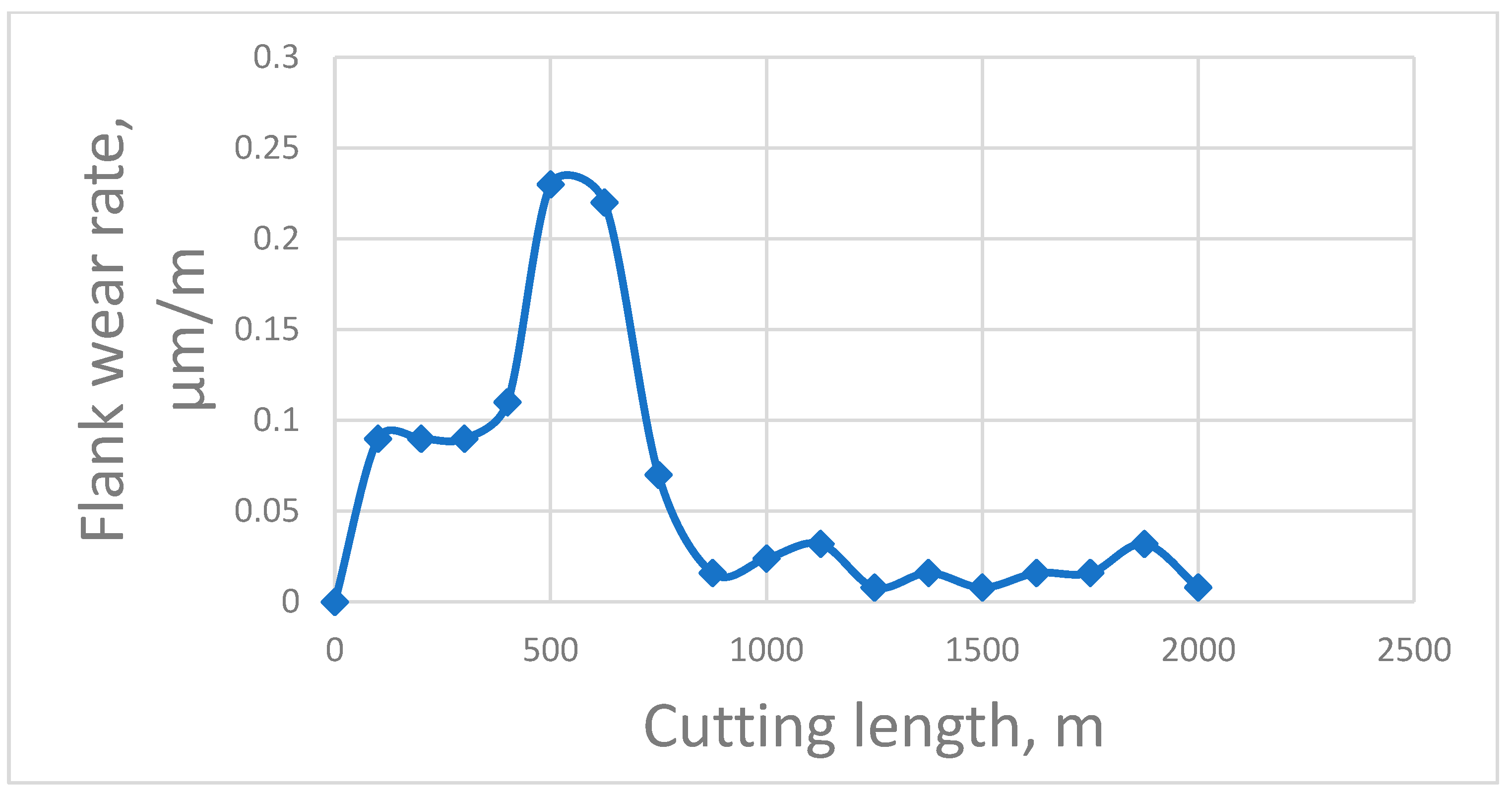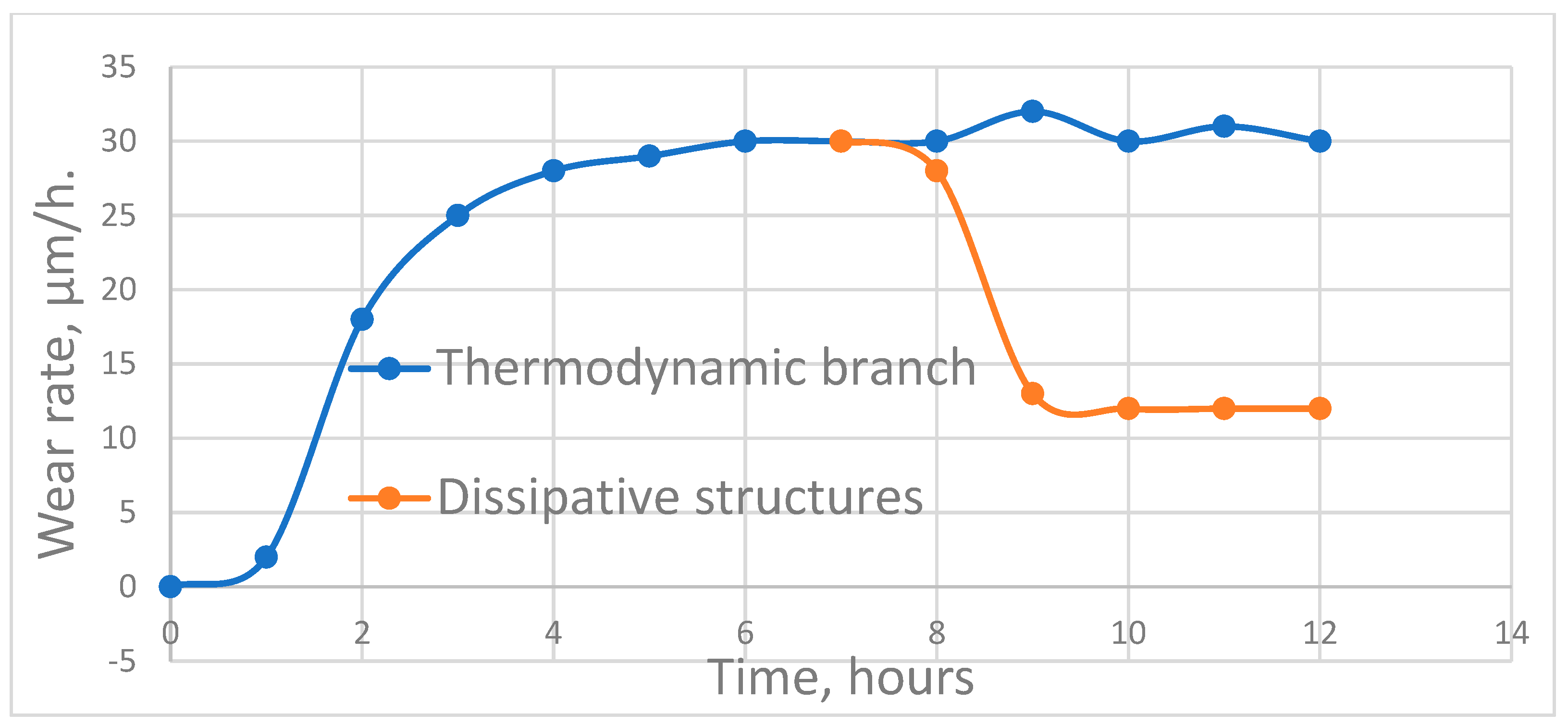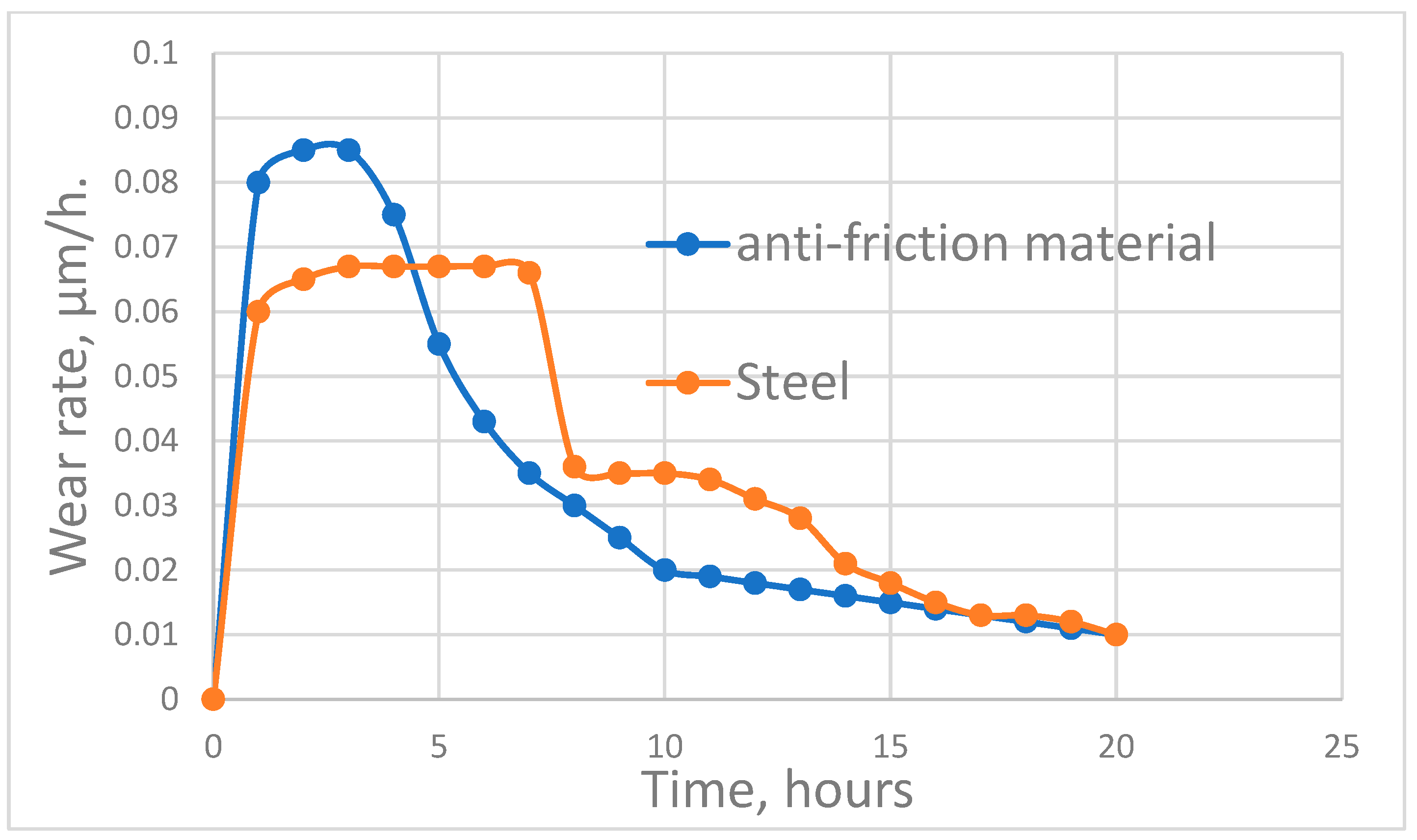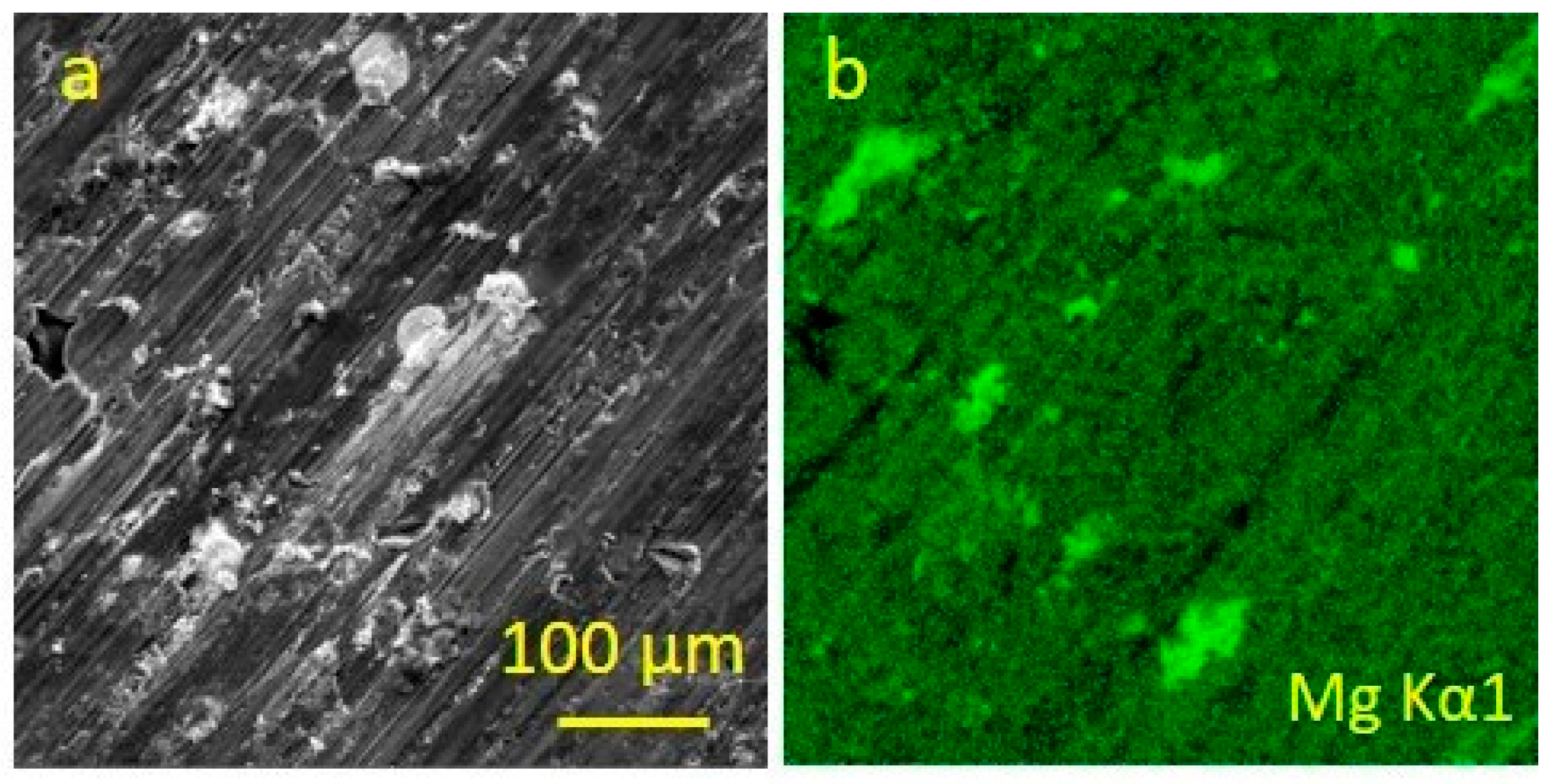The Conditions Necessary for the Formation of Dissipative Structures in Tribo-Films on Friction Surfaces That Decrease the Wear Rate
Abstract
1. Introduction
2. Theoretic Analysis
3. Experimental
- First, the amount of electric current was increased to determine the value of the current at which a sharp decrease occurred in the intensity of wear (self-organization) and bifurcation. The tests were then carried out at this value of the current (75 A) [48,51]. The weight wear of the current-removing materials was measured every hour;
- A metal-cutting system (end milling of stainless steel using carbide cutting tool with an (Al-Ti)N coating [49]). Semi-finish turning cutting tests were performed. All turning tests were conducted at a cutting speed of 320 m/min, feed rate of 0.2 m/rev, and depth of cut of 1 mm under wet conditions [55];
- A plain-bearing crankshaft system (a friction pair composed of aluminum antifriction alloy steel with lubrication) [47,52]. The tribological tests were carried out based on a shoe-and-roller scheme. The shoe was made of an antifriction aluminum alloy (Al-5.8%Sn-2.7%Pb-4.1%Cu-2.3%Zn-1.5%Mg-1.5%Si-0.03%Ti) while the roller consisted of chromium–nickel steel SNC28 steel (Hakuro Group, Kasai, Japan) was an analogue. The radius of the shoe and the roller was 20 mm, while both of their thicknesses were 10 mm. The steel roller rotated at a speed of 500 rpm. The shoe was pressed against the roller with a force of 167 N. Tests were carried out in API CB oil. The weight wear of the roller and shoe was measured at every hour [52,53].
4. Results
5. Conclusions
Author Contributions
Funding
Institutional Review Board Statement
Informed Consent Statement
Data Availability Statement
Acknowledgments
Conflicts of Interest
References
- Bowden, F.P.; Tabor, D. The Friction and Lubrication of Solids; Clarendon Press: Oxford, UK, 1986. [Google Scholar]
- Tabor, D. Friction as dissipative process. In Fundamentals of Friction: Macroscopic and Microscopic Processes; Singer, I.L., Pollock, H.M., Eds.; Kluwer Academic Publishers: Dordrecht, The Netherlands, 1992; Volume 220, pp. 3–24. [Google Scholar]
- Charpy, G. Study of white alloys called antifriction. Metallographist 1899, 2, 9–55. [Google Scholar]
- Klamecki, B.E. An entropy-based model of plastic deformation energy dissipation in sliding. Wear 1984, 96, 319–329. [Google Scholar] [CrossRef]
- Klamecki, B.E. A thermodynamic model of friction. Wear 1980, 63, 113–120. [Google Scholar] [CrossRef]
- Klamecki, B.E. Energy dissipation in sliding. Wear 1982, 77, 115–128. [Google Scholar] [CrossRef]
- Klamecki, B.E. Wear—Entropy production model. Wear 1980, 58, 325–330. [Google Scholar] [CrossRef]
- Gershman, I.S.; Bushe, N.A. Realization of dissipative self-organization on the friction surface of tribosystems. J. Frict. Wear 1995, 16, 61–70. [Google Scholar]
- Bryant, M.D.; Khonsari, M.M.; Ling, F.F. On the thermodynamics of degradation. Proc. R. Soc. A 2008, 464, 2001–2014. [Google Scholar] [CrossRef]
- Prigogine, I. Etude Thermodynamique des Processus Irreversible; Desoer: Liege, Belgium, 1947. [Google Scholar]
- Amiri, M.; Khonsari, M. On the Thermodynamics of Friction and Wear—A Review. Entropy 2010, 12, 1021–1049. [Google Scholar] [CrossRef]
- Nosonovsky, M.; Mortazavi, V. Self-Organization at the Frictional Interface in Green Tribology; Springer: Berlin/Heidelberg, Germany, 2012; pp. 71–78. [Google Scholar]
- Bershadsky, L.I. On Self-organizing and concept of tribosystem. J. Frict. Wear 1992, 13, 101–114. [Google Scholar]
- Bryant, M.D. Entropy and dissipative processes of friction and wear. FME Trans. 2009, 37, 55–607. [Google Scholar]
- Nosonovsky, M. Entropy in tribology: In the search for application. Entropy 2010, 12, 1345–1390. [Google Scholar] [CrossRef]
- Nosonovsky, M.; Mortazavi, V. Friction-Inducied Vibrations and Self-Organization: Mechanics and Non-Eqilibrium Thermodinamics of Sliding Contact; CRC Press: Boca Raton, FL, USA, 2013. [Google Scholar]
- Nosonovsky, M.; Bhushan, B. Thermodinamics of surface degradation, self-organization and self-healing of biomimetic surfaces. Philos. Trans. R. Soc. A 2009, 367, 1607–1627. [Google Scholar] [CrossRef] [PubMed]
- Prigogine, I. The End of Certainty; The Free Press: Los Angeles, CA, USA, 1997. [Google Scholar]
- Ziegler, H. An Introduction to Thermomechanics; North-Holland: Amsterdam, The Netherlands, 1983. [Google Scholar]
- Bruers, S. Classification and discussion of macroscopic entropy production principles. arXiv 2007, arXiv:cond-mat/0604482. [Google Scholar]
- Martyushev, L.M.; Seleznev, V.D. Maximum entropy production principle in physics, chemistry and biology. Phys. Rep. 2006, 426, 1–45. [Google Scholar] [CrossRef]
- Zupanovic, P.; Kuic, D.; Losic, Z.B.; Petrov, D.; Juretic, D.; Brumen, M. The maximum entropy production principle and linear irreversible processes. Entropy 2010, 12, 996–1005. [Google Scholar] [CrossRef]
- Onsager, L. Reciprocal Relations in Irreversible Processes. II . Phys. Rev. 1931, 38, 2265–2279. [Google Scholar] [CrossRef]
- Prigogine, I. Introduction to Thermodynamics of Irreversible Processes; John Wiley: New York, NY, USA, 1967. [Google Scholar]
- Martyushev, L.M. Entropy and Entropy Production: Old Misconceptions and New Breakthroughs. Entropy 2013, 15, 1152–1170. [Google Scholar] [CrossRef]
- Prigogine, I.; Wiame, J.-M. Biologie et thermodynamique des phenomenes irreversibles. Experientia 1946, 2, 451–453. [Google Scholar] [CrossRef]
- Prigogine, I. From Being to Becoming; WH Freeman and Company: San Francisco, CA, USA, 1980. [Google Scholar]
- Nicolis, G.; Prigogine, I. Self-Organization in Nonequilibrium Systems; John Wiley & Sons: New York, NY, USA, 1977. [Google Scholar]
- Zotin, A.I.; Zotina, R.S. Thermodynamic aspects of developmental biology. J. Theor. Biol. 1967, 17, 57–75. [Google Scholar] [CrossRef]
- Zotin, A.I. Thermodynamic Bases of Biological Processes: Physiological Reactions and Adaptations; Walter de Gruyter: Berlin, Germany, 1990. [Google Scholar]
- Zotin, A.I.; Zotina, R.S. Phenomenological Theory of Development, Growth and Aging; Nauka: Moscow, Russia, 1993. (In Russian) [Google Scholar]
- Zotin, A.A.; Zotin, A.I. Thermodynamic bases of developmental processes. J. Non-Equilib. Therm. 1996, 21, 307–320. [Google Scholar] [CrossRef]
- Zotin, A.I.; Zotin, A.A. Direction, Rate and Mechanism of Progressive Evolution; Nauka: Moscow, Russia, 1999. (In Russian) [Google Scholar]
- Zotin, A.I.; Lamprecht, I. Aspects of Bioenergetics and Civilization. J. Theor. Biol. 1996, 180, 207–214. [Google Scholar] [CrossRef] [PubMed]
- Virgo, N. From Maximum Entropy to Maximum Entropy Production: A New Approach. Entropy 2010, 12, 107–126. [Google Scholar] [CrossRef]
- Lucarini, V. Thermodynamic Efficiency and Entropy Production in the Climate System. Phys. Rev. E 2009, 80, 021118. [Google Scholar] [CrossRef] [PubMed]
- Di Vita, A. Maximum or minimum entropy production? How to select a necessary criterion of stability for a dissipative fluid or plasma. Phys. Rev. E 2010, 81, 041137. [Google Scholar] [CrossRef] [PubMed]
- Niven, R.K. Maximum entropy analysis of steady-state flow systems (and extremum entropy production principles). AIP Conf. Proc. 2012, 1443, 270. [Google Scholar]
- Zupanovic, P.; Botri, S.; Juretic, D.; Kuic, D. Relaxation Processes and the Maximum Entropy Production Principle. Entropy 2010, 12, 473–479. [Google Scholar] [CrossRef]
- Županović, P.; Kuić, D.; Juretić, D.; Dobovišek, A. On the Problem of Formulating Principles in Nonequilibrium Thermodynamics. Entropy 2010, 12, 926–931. [Google Scholar] [CrossRef]
- Weaver, I.; Dyke, J.G.; Oliver, K. Can the principle of Maximum Entropy Production be used to predict the steady states of a Rayleigh-Bernard convective system? In Beyond the Second Law; Dewar, R.C., Lineweaver, C.H., Niven, R.K., Regenauer-Lieb, K., Eds.; Springer: Berlin/Heidelberg, Germany, 2014; pp. 277–290. [Google Scholar]
- Osara, J.A.; Bryan, M.D. Thermodynamics of grease degradation. Tribol. Int. 2019, 137, 433–445. [Google Scholar] [CrossRef]
- Osara, J.A.; Bryan, M.D. A temperature-only system degradation analysis based on thermal entropy and the degradation-entropy generation methodology. Int. J. Heat Mass Transf. 2020, 158, 120051. [Google Scholar] [CrossRef]
- Osara, J.A.; Bryan, M.D. Evaluating Degradation Coefficients from Existing System Models. Appl. Mech. 2021, 2, 159–173. [Google Scholar] [CrossRef]
- Klimontovich, Y.I. Introduction in Physics of Open Systems; Yanus: Moscow, Russia, 2002. [Google Scholar]
- Glansdorff, P.; Prigogine, I. Thermodynamic Theory of Structure, Stability and Fluctuations; Wiley: London, UK, 1971. [Google Scholar]
- Kondepudi, D.; Prigogine, I. Modern Thermodynamics; John Wiley & Sons: New York, NY, USA, 1999. [Google Scholar]
- Gershman, I.; Gershman, E.I.; Mironov, A.E.; Fox-Rabinovich, G.S.; Veldhuis, S.C. Application of the Self-Organization Phenomenon in the Development of Wear Resistant Materials—A Review. Entropy 2016, 18, 385. [Google Scholar] [CrossRef]
- Fox-Rabinovich, G.; Paiva, J.M.; Gershman, I.; Aramesh, M.; Cavelli, D.; Yamamoto, K.; Dosbaeva, G.; Veldhuis, S. Control of Self-Organized Criticality through Adaptive Behavior of Nano-Structured Thin Film Coatings. Entropy 2016, 18, 290. [Google Scholar] [CrossRef]
- Fox-Rabinovich, G.; Gershman, I.S.; Locks, E.; Paiva, J.M.; Endrino, J.L.; Dosbaeva, G.; Veldhuis, S. The Relationship between Cyclic Multi-Scale Self-Organized Processes and Wear-Induced Surface Phenomena under Severe Tribological Conditions Associated with Buildup Edge Formation. Coatings 2021, 11, 1002. [Google Scholar] [CrossRef]
- Gershman, I.S. Formation of Secondary Structures and the Self-Organization Process of Tribosystems during Friction with the Collection of Electric Current. In Self-Organization during Friction. Advanced Surface Engineered Materials and Systems Designed; Taylor & Francis Group: Boca Raton, FL, USA, 2006; Chapter 8; pp. 197–230. [Google Scholar]
- Gershman, I.S.; Mironov, A.E.; Gershman, E.I.; Fox-Rabinovich, G.S.; Veldhuis, S.C. Self-Organization during Friction of Slide Bearing Antifriction Materials. Entropy 2015, 17, 7967–7978. [Google Scholar] [CrossRef]
- Mironov, A.; Gershman, I.; Gershman, E.; Podrabinnik, P.; Kuznetsova, E.; Peretyagin, P.; Peretyagin, N. Properties of Journal Bearings Materials that Determine their Wear Resistance on the Example of Aluminum Based Alloys. Materials 2021, 14, 535. [Google Scholar] [CrossRef]
- Feistel, R.; Ebeling, W. Introduction to the Field of Self-Organization. In Physics of Self-Organization and Evolution; Wiley-VCH Verlag GmbH & Co., KGaA: Weinheim, Germany, 2011; pp. 1–33. [Google Scholar]
- Fox-Rabinovich, G.; Kovalev, A.; Gershman, I.; Wainstein, D.; Aguirre, M.H.; Covelli, D.; Paiva, J.; Yamamoto, K.; Veldhuis, S. Complex Behavior of Nano-Scale Tribo-Ceramic Films in Adaptive PVD Coatings under Extreme Tribological Conditions. Entropy 2018, 20, 989. [Google Scholar] [CrossRef]
- Heinecke, G. Tribochemistry; Akademie Verlag: Berlin, Germany, 1984. [Google Scholar]
- Podrabinnik, P.; Gershman, I.; Mironov, A.; Kuznetsova, E.; Peretyagin, P. Tribochemical Interaction of Multicomponent Aluminum Alloys During Sliding Friction with Steel. Lubricants 2020, 8, 24. [Google Scholar] [CrossRef]
- Predel, F. (Ed.) Phase Equilibria, Crystallographic and Thermodynamic Data of Binary Alloys; Landolt-Börstein/New Series IV/5; Springer: Berlin/Heidelberg, Germany, 1998. [Google Scholar]






Disclaimer/Publisher’s Note: The statements, opinions and data contained in all publications are solely those of the individual author(s) and contributor(s) and not of MDPI and/or the editor(s). MDPI and/or the editor(s) disclaim responsibility for any injury to people or property resulting from any ideas, methods, instructions or products referred to in the content. |
© 2023 by the authors. Licensee MDPI, Basel, Switzerland. This article is an open access article distributed under the terms and conditions of the Creative Commons Attribution (CC BY) license (https://creativecommons.org/licenses/by/4.0/).
Share and Cite
Gershman, I.S.; Fox-Rabinovich, G.; Gershman, E.; Mironov, A.E.; Endrino, J.L.; Podrabinnik, P. The Conditions Necessary for the Formation of Dissipative Structures in Tribo-Films on Friction Surfaces That Decrease the Wear Rate. Entropy 2023, 25, 771. https://doi.org/10.3390/e25050771
Gershman IS, Fox-Rabinovich G, Gershman E, Mironov AE, Endrino JL, Podrabinnik P. The Conditions Necessary for the Formation of Dissipative Structures in Tribo-Films on Friction Surfaces That Decrease the Wear Rate. Entropy. 2023; 25(5):771. https://doi.org/10.3390/e25050771
Chicago/Turabian StyleGershman, Iosif S., German Fox-Rabinovich, Eugeniy Gershman, Alexander E. Mironov, Jose Luis Endrino, and Pavel Podrabinnik. 2023. "The Conditions Necessary for the Formation of Dissipative Structures in Tribo-Films on Friction Surfaces That Decrease the Wear Rate" Entropy 25, no. 5: 771. https://doi.org/10.3390/e25050771
APA StyleGershman, I. S., Fox-Rabinovich, G., Gershman, E., Mironov, A. E., Endrino, J. L., & Podrabinnik, P. (2023). The Conditions Necessary for the Formation of Dissipative Structures in Tribo-Films on Friction Surfaces That Decrease the Wear Rate. Entropy, 25(5), 771. https://doi.org/10.3390/e25050771








